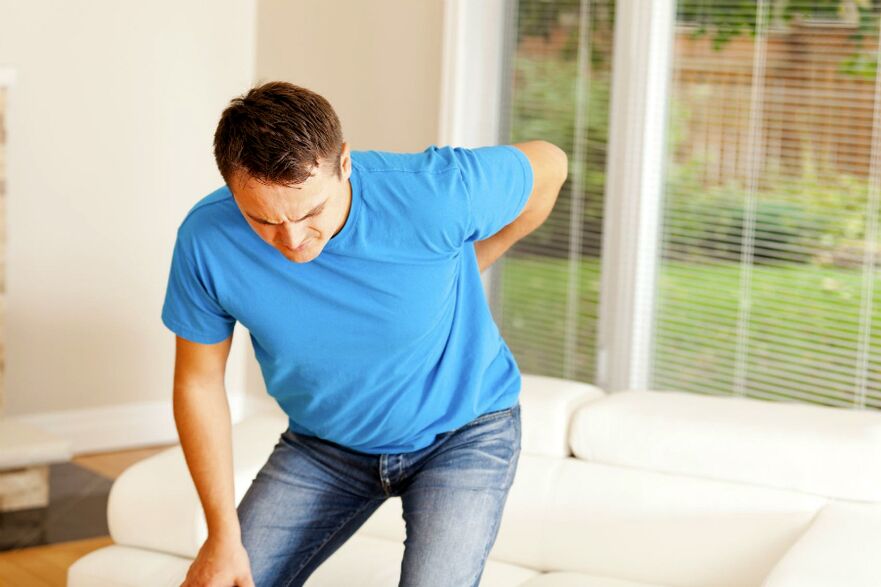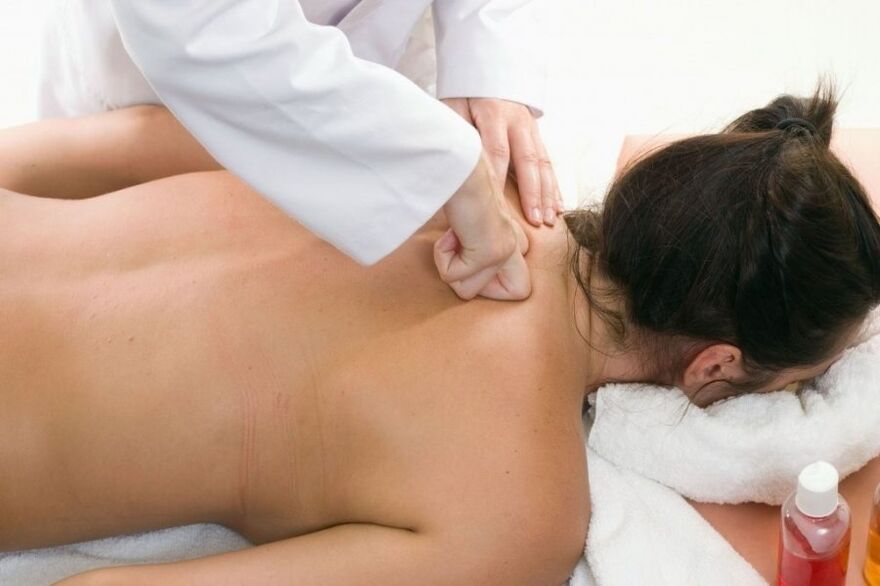
Complaints about back pain are one of the most common reasons for visiting a doctor. Pain in this part of the body can be a manifestation of normal fatigue caused by excessive physical exertion, or it can indicate the presence of serious health problems that require competent treatment.
Back pain is an unpleasant manifestation of many diseases or severe overexertion of the back muscles for other reasons.
In most cases, this pathology occurs against the background of various changes in the structure of the joints of the spine, as well as in the adjacent muscles, nerve endings, or skin above the spine. Also, such a symptom accompanies some diseases or malfunctions of internal organs.
Causes of back pain
The back can hurt in cases where there is a pathology of:
- spine;
- musculoskeletal apparatus;
- internal organs.
Pain can also occur in a healthy person due to muscle pain due to major physical exertion.
spinal pathology
In addition, frequent pathologies of the spine are considered, against which a pain syndrome occurs.
osteochondrosis
Osteochondrosis is the most common answer to the question: "why does my back hurt? "With this pathology, degenerative changes occur in the intervertebral cartilage, from which the cartilage becomes thinner, the space between the vertebrae decreases and the nerve roots can be pinched. For pain in osteochondrosis, the following symptoms are characteristic:
- occur during or after physical exertion, as well as a long stay in a static position;
- it can have a stinging or painful character;
- movement makes the pain worse.
If the sciatic nerve is pinched and sciatica develops, the pain is transmitted to the buttocks, radiating along the surface of the thigh from behind. There may be a violation of sensitivity (numbness, tingling, burning). With lumbago, there is often a stabbing or stabbing pain that causes the patient to literally freeze in place. Patients complain that they have been shot or have their backs twisted.
injuries
Injuries most often occur during falls (in icy conditions, while playing sports) or blows to the back during traffic accidents. Pain can cause both bruises and more serious injuries - fractures and dislocations of the vertebral bodies. The pain in an injury can be of the most diverse nature:
- pain,
- fire,
- shooting,
- fool.
Pain sensations can be constantly disturbing, occur with certain movements, or feel like a pulsation, depending on the nature and location of the damage. It is important to know that serious injuries are not always caused by major blows.
For example, a compression fracture of the spine in the elderly can be caused by a slight mechanical load, and the first day after the injury, the vertebra does not hurt much. In the future, if immobilization and treatment measures are not taken, the pain will increase and the nerves and spinal cord may be damaged.
Any spinal injury, even minor, at first glance, requires a medical examination.
intervertebral hernia
An intervertebral hernia is a protrusion of a fragment of the intervertebral disc into the spinal canal. A hernia is usually the result of degenerative changes in the spine or is the result of an injury. A disc bulge can occur anywhere in the spine, but it occurs much more often in the lumbar region, since it is he who bears the main load.
In the early stages of hernia formation, back pain is caused by physical activity, occurs from time to time, and is of low intensity. With disease progression or an acute loss of a disc fragment, the pain can be very severe, stabbing in nature with radiation to the legs.
Often, patients complain of a numbness or burning sensation in the problem area, as well as in the lower or upper extremities. This indicates that there was an infringement of the nerve endings. Severe pain provokes muscle spasm, which leads to a violation of posture, pathological kyphosis or lordosis develops.
Spinal curvature (kyphosis, lordosis, scoliosis)
With the curvature of the spine, to compensate for the pathological curvature, there is significant muscle tension, which leads to frequent and sometimes constant dull pain in the back.
Muscle pain
85% of cases of chronic or recurring back muscle pain are associated with excessive stress on the lower back. Even for those who do not carry significant sports loads and do not carry heavy loads, the back muscles experience daily strain. This is especially true for long-term static loads during sedentary computer work.
Muscles that aren't warmed up can be easily injured by making a sharp turn, lifting a heavy object, or making a wrong move. Pain can occur due to inflammatory diseases of the muscles (myositis) or due to severe stress, leading to a reflex spasm of muscle fibers.
infectious diseases
Tuberculosis most often affects the spine. In the vertebrae, the infection penetrates hematogenously (through the blood) and causes inflammation, and then bone necrosis. Pain in the lumbar and thoracic region is a characteristic sign of spinal tuberculosis, and neurological symptoms appear in half of patients: there is a feeling of numbness and weakness in the limbs.
In addition, common manifestations are characteristic of spinal tuberculosis:
- weakness,
- perspiration,
- increased body temperature,
- rapid fatigue,
- little appetite
oncological diseases
In most cases, a malignant tumor does not develop in the spine. Cancer cells arrive here with the flow of blood or lymph from other foci. Most often, metastases in the spine lead to cancer of the mammary glands, lungs, and prostate. At first, the pains may resemble the manifestations of ordinary osteochondrosis, but then the back aches constantly, with increasing intensity.
It is not always possible to eliminate pain with conventional painkillers, only the introduction of narcotic drugs brings relief. With multiple metastases, the pain is wandering in nature, covering different parts of the spine. In addition to back pain, the patient feels weakness, unreasonable weight loss, fever to subfebrile numbers. The prognosis is unfavourable.
Diseases of the gastrointestinal tract
The most common back pain occurs with pancreatitis. It is enveloping in nature and quite intense. In acute pancreatitis, the pain may be accompanied by a drop in blood pressure and loss of consciousness. Acute pancreatitis is an indication for emergency hospitalization of the patient in a surgical hospital.
In addition to pancreatitis, pain can radiate to the back with a peptic ulcer or biliary colic attack.
Diseases of the genitourinary system
Kidney diseases, especially urolithiasis, during exacerbation often give pain in the lumbar region. If the lower back hurts, the pain is accompanied by a violation of urination or given in the inguinal region, then a surgeon's consultation is necessary, and women should undergo an examination by a gynecologist to exclude inflammation of the appendages or the presence of an ectopic pregnancy.
Back pain in pregnant women
Pregnant women often complain of throbbing or aching pain in the back and lower back, especially in the later stages. This is due to the fact that in the second half of pregnancy, due to a significant increase in the uterus, the center of gravity changes and the load on the lower back muscles increases. The pains are usually dull, aggravated by changing the position of the body, in particular, when getting up from a chair or armchair.
What to do if your back hurts
If your back hurts for more than three days, you should see a doctor. Seek immediate medical attention if your back pain is accompanied by:
- poor general health;
- a decrease or a sharp increase in blood pressure;
- an increase in body temperature;
- malfunction of any internal organ.
Also, you should call a doctor if the pain was preceded by an injury or with a great intensity of pain.
Diagnosis
In most cases, the doctor will be able to make a preliminary diagnosis on the initial exam. However, to determine exactly what causes back pain, further study is required. In most cases, these are X-rays in two projections, computed tomography of the spine (CT), nuclear magnetic resonance (MRI).
If necessary, the doctor may prescribe a general blood and urine test, an electrocardiogram, an ultrasound scan of the abdominal cavity or small pelvis, and an image of the lungs. An examination should be completed without fail, since even the most serious diseases in the early stages of detection with proper treatment have a favorable prognosis.
Treatment
How to get rid of back pain, only a doctor can recommend based on examination data and examination results. The main principles of therapy: the elimination of severe pain and inflammation, the impact on the cause that caused the pain, rehabilitation measures aimed at accelerating tissue regeneration processes and restoring normal life (physiotherapy, exercise therapy , massage, proper nutrition).
How to ease the pain
To relieve pain, it is first necessary to limit physical activity. Of the pharmacological drugs, nonsteroidal anti-inflammatory drugs are most often prescribed. These medications can be taken as tablets or injections, and are also included in topical ointments. Treatment of back pain caused by muscle spasms is carried out with warm ointments, alcohol compresses and a warm bath. With severe spasms, muscle relaxants are prescribed.
It is important to remember that in case of inflammatory diseases of the internal organs and the first day after the injury, any thermal procedures are contraindicated. They cause deterioration of health and progression of the pathology. After the elimination of the acute manifestations of the disease, physiotherapeutic procedures, massage and therapeutic exercises are prescribed. If a pregnant woman's back hurts, then the use of medication is undesirable.
Using a special bandage and limiting physical activity will help pregnant women relieve back pain.
Physiotherapy
Exercise therapy (therapeutic gymnastics) is the basis for the successful treatment of back pain in any localization. A physical therapy exercise specialist or rehabilitation doctor may recommend a set of exercises. Classes begin with simple exercises, gradually increasing the load on the muscles and ligaments of the back and lower back.
This leads to the strengthening of the muscular corset that supports the spine, posture alignment, activation of blood circulation and metabolism in the tissues, improvement of general well-being and mood. It is illiterate to treat the back with medication without regular exercise therapy and proper nutrition. This will only give a temporary effect.
Physiotherapy
Procedures such as phonophoresis with medicinal substances, magnetic therapy and laser therapy will help speed up recovery. During the remission period, it is effective to undergo mud therapy and paraffin therapy.

Prevention
To avoid back pain, it is very important to lead a healthy lifestyle, which includes:
- a balanced diet with enough vitamins and minerals;
- maintain a normal body weight;
- regular physical education classes aimed at strengthening the muscles of the back and abdominals;
- contact a doctor if any disease appears and its timely treatment.
Back pain requires a mandatory diagnosis to determine the cause of its appearance and long-term treatment, based mainly on changing the patient's lifestyle. In the acute period of the disease, the patient is assisted by pharmacological preparations. If you follow all the doctor's recommendations, the prognosis in most cases is favorable.


















